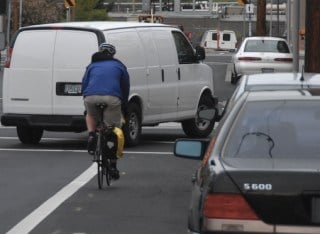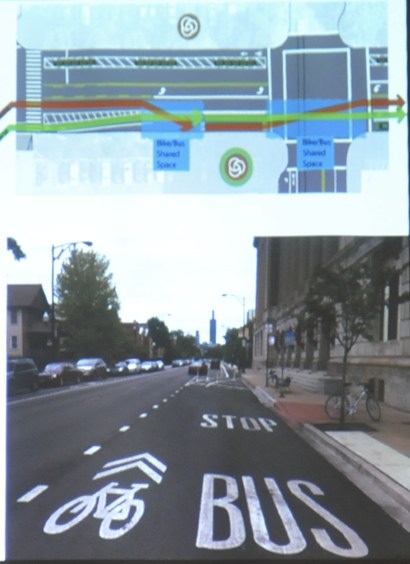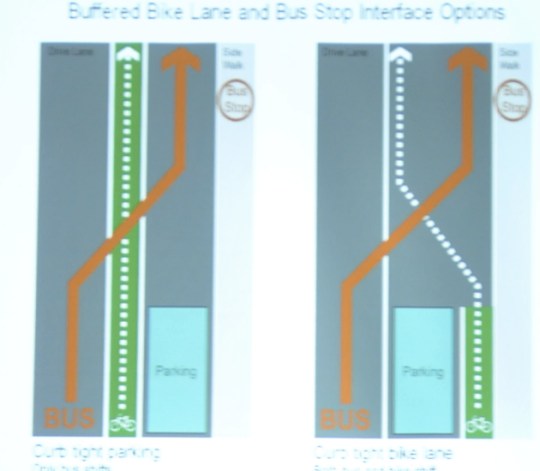
(Photo © J. Maus/BikePortland)
One of the biggest urban bicycling planning conundrums facing Portland (and other cities?) right now is how to decrease the prevalence of right-hook collisions.
The majority of our bikeways here in Portland are to the immediate right of right-turning motor vehicle traffic at intersections. That scenario brings with it some inherent safety issues and it has led to more tragedy than I care to remember. While experts have told me that overall, right-hooks do not tend to be as serious as other types of collisions; they happen quite frequently and as we all know, they can have fatal results.
The problem really crystallized for me recently, when at a meeting of the City’s Bicycle Advisory Committee, a Bureau of Transportation staffer said, “We have not figured out a good solution to making bikes visible when cars are making a right turn.”
To hear PBOT admit this is both fascinating and frustrating. This is a stalemate with very real and human consequences. Are we just supposed to accept all these right-hooks? Can PBOT really not figure this out? Or are they constraining their menu of possible solutions to what they feel is politically feasible, rather than what’s technically possible?
The reason I’m posting this today is because a reader sent in video of a right-hook last week. The video shows someone biking down NE Couch approaching Grand. This intersection is one of several in Portland where PBOT has struggled with mitigating a known right-hook hazard.
At NE Couch and Grand, PBOT first looked to green paint and a bike box to increase safety. Then, after that proved inadequate, they installed an illuminated LED sign. As we can see in the video, the problem persists.
As the entire city was tragically reminded of back in May, right-hooks remain the boogeyman on the loose in Portland’s bike story. We are grappling with them on N Broadway/Wheeler and they are a constant threat on SW Broadway. On N Williams Ave, where PBOT is poised to try a left-side bike lane, some are concerned about left-hooks (same problem, different side).
The good news is, PBOT cares about this stuff and they’re actively working on the issue. On the NE Multnomah project, several scenarios are being discussed. One debate that’s forming is whether it’s safer to put bike traffic curbside at intersections (the classic cycle track design with more protection from moving auto traffic) or to have cars at the curb and bikes in a buffered bike lane adjacent to moving traffic. Bike planners and advocates tend to favor the curbside, cycle track solution, while it seems PBOT thinks the added visibility of bike riders adjacent to car operators is safer.
And then there are intersections with bus stops on the corner. Which bikeway design is safer in these situation? Below are two slides from the June Bike Advisory Committee meeting where PBOT made a presentation about how to deal with corner bus stops and the bike lane in the NE Multnomah project:


While this is a major issue here in Portland, it’s important to remember that — barring a full network of completely separate roads for bikes and cars — right/left-hooks can never be completely engineered out of a system. We can’t expect PBOT engineers to prevent collisions from happening; but we should expect them to be as bold, open-minded, and innovative as possible when coming up with a solution.


